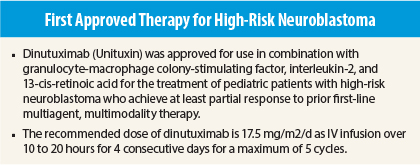In the Clinic provides overviews of novel oncology agents, addressing indications, mechanisms, administration recommendations, safety profiles, and other essential information needed for the appropriate clinical use of these drugs.
On March 10, 2015, the chimeric monoclonal antibody dinutuximab (Unituxin) was approved for use in combination with granulocyte-macrophage colony-stimulating factor (GM-CSF), interleukin-2 (IL-2), and 13-cis-retinoic acid (RA) for the treatment of pediatric patients with high-risk neuroblastoma who achieve at least partial response to prior first-line multiagent, multimodality therapy.1,2
Supporting Trial
Approval was based on demonstration of improved event-free survival and overall survival in a multicenter, open-label trial conducted by the Children’s Oncology Group.2 Patients had to have achieved at least partial response to prior therapy for newly diagnosed high-risk neuroblastoma, consisting of induction combination chemotherapy, maximum feasible surgical resection, and myeloablative consolidation chemotherapy, and had also received autologous stem cell transplantation and radiotherapy. A total of 226 patients were randomized to the dinutuximab/RA group (n = 113) or the RA-alone group (n = 113) for 6 cycles of treatment. Dinutuximab/RA treatment consisted of dinutuximab in combination with GM-CSF and RA (cycles 1, 3, and 5), dinutuximab in combination with IL-2 and RA (cycles 2 and 4), and RA (cycle 6).
Patients had a median age of 3.8 years (range = 11 months–15 years), 60% were male, 82% were white, 80% had International Neuroblastoma Staging System stage 4 disease, 46% had neuroblastoma that was not MYCN-amplified and 36% had tumors with known MYCN amplification, and 43% had hyperdiploid tumors and 36% had diploid tumors. Therapy prior to stem cell transplantation resulted in complete response in 35%, very good partial response in 43%, and partial response in 23%.
Median event-free survival was not reached in the dinutuximab/RA group vs 1.9 years in the RA group (hazard ratio [HR] = 0.57, P = .01). An analysis conducted at 3 years after the event-free survival analysis showed improved overall survival in the dinutuximab group (HR = 0.58, 95% confidence interval = 0.37–0.91), with median survival not yet reached in either group.
How It Works
Dinutuximab is a chimeric monoclonal antibody composed of a combination of mouse and human DNA. It binds to the glycolipid GD2, which is expressed on neuroblastoma cells and on normal cells of neuroectodermal origin (including the central nervous system and peripheral nerves). Dinutuximab binding induces cell lysis of GD2-expressing cells through antibody-dependent cell-mediated cytotoxicity and complement-dependent cytotoxicity.
How It Is Given
The recommended dose of dinutuximab is 17.5 mg/m2/d as IV infusion over 10 to 20 hours for 4 consecutive days for a maximum of 5 cycles. Dinutuximab is given on days 4, 5, 6, and 7 of 24-day cycles 1, 3, and 5 and on days 8, 9, 10, and 11 of 32-day cycles 2 and 4. Infusion should be initiated at a rate of 0.875 mg/m2/h for 30 minutes. The infusion rate can be gradually increased as tolerated to a maximum rate of 1.75 mg/m2/h. Patients must have adequate hematologic, respiratory, hepatic, and renal function prior to initiating each course of treatment. Required pretreatment includes hydration and analgesic, antihistamine, and antipyretic treatment prior to each infusion.
Permanent discontinuation of dinutuximab is required for grade 3 or 4 anaphylaxis, grade 3 or 4 serum sickness, grade 3 pain unresponsive to maximum supportive measures, grade 4 sensory neuropathy or grade 3 sensory neuropathy that interferes with daily activities for more than 2 weeks, grade 2 peripheral motor neuropathy, subtotal or total vision loss, and grade 4 hyponatremia despite appropriate fluid management. Dose modifications including dose reduction and interruption are specified in product labeling for infusion-related reactions, capillary leak syndrome, hypotension requiring medical intervention, severe systemic infection or sepsis, and neurologic disorders of the eyes.
Safety Profile
Safety data include those from 134 dinutuximab/RA patients (including 25 nonrandomized patients) and 106 RA patients. In the randomized trial, adverse events of grade ≥ 3 were comprehensively collected, but those of grade 1 or 2 were collected sporadically, and laboratory data were not comprehensively collected. The most common grade 3 or 4 adverse events in the dinutuximab/RA group were pain (51% vs 6% in the RA group), lymphopenia (51% vs 20%), pyrexia (40% vs 6%), thrombocytopenia (39% vs 25%), hypokalemia (37% vs 2%), anemia (34% vs 16%), neutropenia (34% vs 13%), infusion reaction (25% vs 1%), capillary leak syndrome (23% vs 0%), hyponatremia (23% vs 4%), and increased alanine transaminase levels (23% vs 3%). The most common serious adverse events occurring in at least 5% of dinutuximab/RA patients were infection, infusion reaction, hypokalemia, hypotension, pain, fever, and capillary leak syndrome. Treatment was discontinued due to adverse events in 19% of the dinutuximab/RA group.
Dinutuximab carries boxed warnings for infusion reactions, including life-threatening reactions, and neuropathy, including severe neuropathic pain, peripheral sensory neuropathy, and motor neuropathy. The drug is contraindicated in patients with a history of anaphylaxis to dinutuximab.
Dinutuximab carries warnings/precautions for capillary leak syndrome and hypotension, infection, neurologic disorders of the eyes, bone marrow suppression, electrolyte abnormalities, atypical hemolytic uremic syndrome, and embryo-fetal toxicity. Peripheral blood cell counts must be monitored during dinutuximab treatment, and serum electrolytes must be closely monitored. Female patients must be advised of the potential risk to a fetus and to use effective contraception. ■
References
1. U.S. Food and Drug Administration: Approved drugs. Dinutuximab. Available at http://www.fda.gov/Drugs/InformationOnDrugs/ApprovedDrugs/ucm437480.htm. Accessed March 23, 2015.
2. Unituxin (dinutuximab) injection prescribing information, United Therapeutics Corporation, March 2015. Available at http://www.accessdata.fda.gov/drugsatfda_docs/label/2015/125516s000lbl.pdf. Accessed March 23, 2015.
Report Adverse Events
Health-care professionals should report all serious adverse events suspected to be associated with the use of any medicine or device to FDA’s MedWatch Reporting System by completing a form online at http://www.fda.gov/medwatch/report.htm, by faxing (1-800-FDA-0178), by mailing the postage-paid address form provided online, or by telephone (1-800-FDA-1088).


